On October 3, 1990, East and West Germany were officially reunited after decades of division. This event marked the end of one of the most striking symbols of the Cold War—the separation of a nation and its people. For Germans, it was not only a political event, but also an emotional and cultural homecoming that reshaped Europe.
The story of German division began in the aftermath of World War II. After Nazi Germany’s defeat in 1945, the Allied Forces—the United States, Great Britain, France, and the Soviet Union—divided the country into four occupation zones. The western zones were managed by the US, Britain, and France, while the eastern zone was controlled by the Soviet Union. Although Berlin, the capital city, was located deep within Soviet territory, it too was split into four sections, with the western sectors controlled by the Allies and the eastern portion under Soviet authority. This uneasy arrangement soon reflected the growing tensions between the capitalist West and the communist East.
By 1949, two new German states were formally established. In May, the western regions joined together to create the Bundesrepublik Deutschland, or the Federal Republic of Germany, commonly called West Germany. In October of the same year, the Soviets responded by establishing the Deutsche Demokratische Republik, or the German Democratic Republic, better known as East Germany. From that point on, two Germanies existed side by side, representing the larger struggle between Western capitalism and Soviet-style communism.
The division was especially difficult in Berlin. Though West Berlin was part of the Federal Republic politically, geographically it was completely surrounded by communist East Germany. For the people who lived there, life often felt like being trapped in an island within hostile territory. In 1961, East German authorities constructed the Berlin Wall, a massive barrier of concrete and barbed wire that separated East and West Berlin. Families were split, friends were cut off from one another, and thousands of East Germans were trapped behind the wall, unable to leave. The Berlin Wall quickly became one of the most powerful symbols of the Cold War.
Over the following decades, East and West Germany developed along very different paths. West Germany became prosperous, aided by US and European support, and established itself as a strong democracy. East Germany, however, remained under strict Soviet influence, with a heavily controlled economy and limited freedoms. Many East Germans longed for the liberties and opportunities enjoyed in the West. Some risked—and often lost—their lives attempting to escape across the border.

By the 1980s, change was on the horizon. The Soviet Union, under the leadership of Mikhail Gorbachev, began reducing its control over Eastern Europe. His policies of glasnost (openness) and perestroika (restructuring) encouraged reforms, and resistance movements grew throughout the communist world. In 1987, during a famous speech in West Berlin, US President Ronald Reagan challenged Gorbachev directly, declaring, “Mr. Gorbachev, tear down this wall!”
Only two years later, in 1989, East Germans began organizing peaceful protests demanding reform and freedom of movement. The pressure became too great for East German leaders to contain. On November 9, 1989, the Berlin Wall finally fell, as jubilant crowds from both sides tore it down piece by piece. Families were reunited, and Berlin once again became a single city.
The fall of the wall opened the door for reunification. Just two weeks later, West German Chancellor Helmut Kohl introduced a 10-point plan to bring East and West Germany together. In May 1990, the two governments signed a treaty creating an economic and social union, aligning their currencies and systems. On August 23, East Germany’s parliament voted to join with the Federal Republic, and the agreement was formally signed on August 31.
Finally, at midnight on October 3, 1990, East and West Germany became one nation again. Celebrations erupted across the country. The German post office even issued two special stamps to mark the historic event. Since then, October 3 has been celebrated every year as the Day of German Unity, a national holiday honoring the triumph of democracy, freedom, and the resilience of the German people.

The reunification of Germany not only changed the lives of its citizens but also signaled the end of the Cold War era in Europe. What had once seemed like an unbridgeable divide between East and West collapsed in a wave of determination and hope. For many, it remains one of the most remarkable moments of the 20th century.
Click here for more Germany stamps.
| FREE printable This Day in History album pages Download a PDF of today’s article. Get a binder or other supplies to create your This Day in History album. |
Discover what else happened on This Day in History.

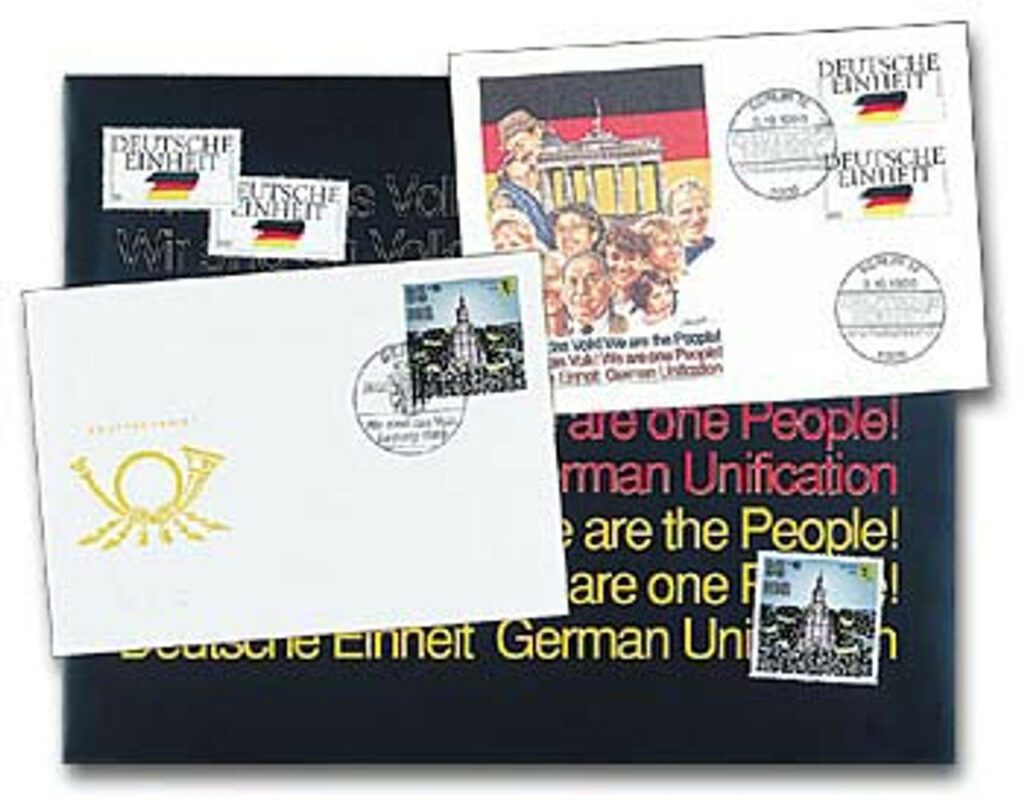
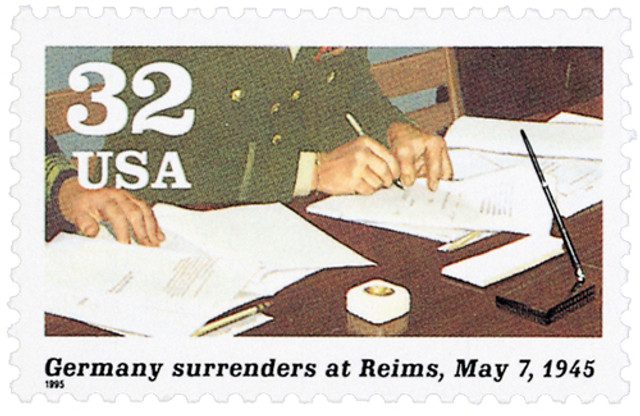
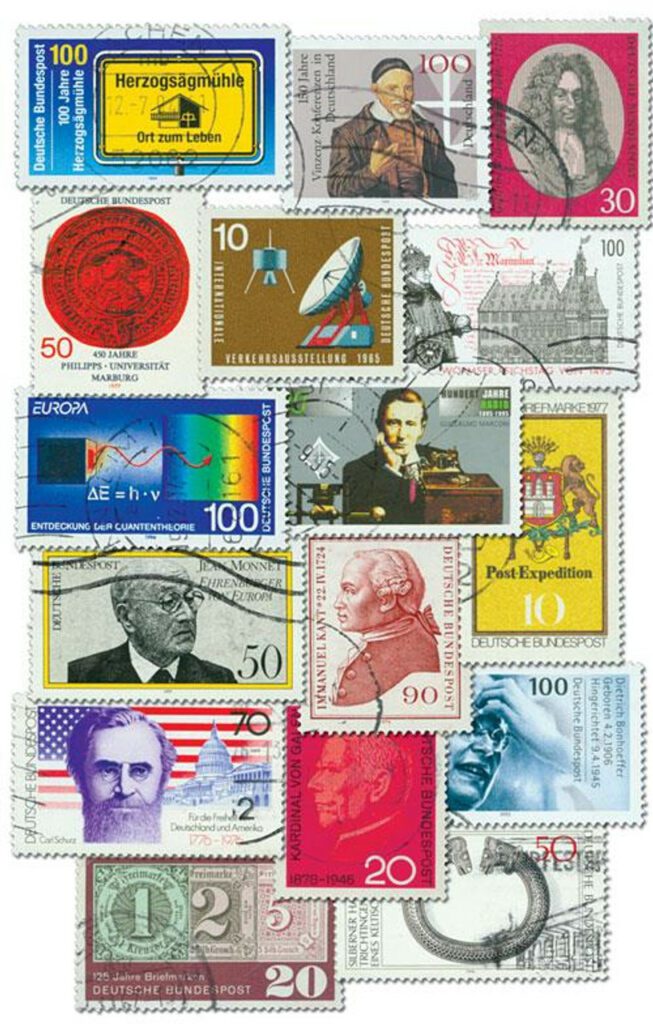
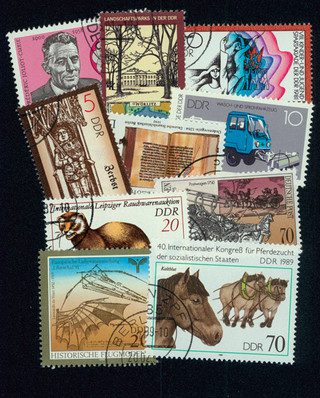
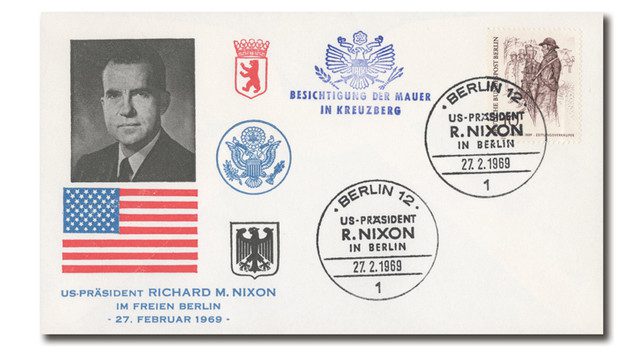

The meeting where Germany was divided was the work of Stalin. Winston Churchill knew this was not the best resolution at the end of the war but he also understood that FDR, while the leader of the country that should have a strong influence in the Allies decision, was ill and did not counter Stalin on the negotiation as he should have.
FDR died in April of 1945 while the was being fought.
How well I remeber, I had four brothers in WW2 and my turn came with Korean service. Let not two idiots, one of ours and one of theirs do a second take on it. The blind in Washington can’t see that Russia is doing to us what we did to the USSR.We made them go broke as we are currently going with the stupidity of our leaders and congress.
More accurately, the Allied Forces didn’t split Germany “in two”, but divided Germany into four occupation zones administered by each of the Allied Powers (France, Britain, US and Soviet Union). It was only later that the Soviet-administered zone (under Soviet direction/pressure) refused to join the other three zones and declared the German (Deutsche) Democratic Republic (DDR).
Active duty USAF that spent over 13-years in various European assignments as well as over eight years stationed in Germany. At the time, I was stationed at Bitburg Air Base, Germany getting ready to deploy for Desert Shield/Storm. Never thought the unification would ever happen-a great experience to actually experience it.
Believe it or not, Americans could enter into East Berlin through Checkpoint Charley as tourists. My Mom, who grew up in Germany but was a US citizen and I briefly crossed over one wnter day in the 1960’s just to see what it was like.
It was just as bleak and depressing a place as everybody at the time said it was. If you never thought about it before, it sure made you appreciate how fortunate you were not to live there.
When we lived in Germany from 1976-1981 it was still divided. One overwhelming visit was to Dachau Concentration Camp outside Munich. It’s something we’d never forget. In 1980, after our daughter Megan was born, we drove from Checkpoint Alpha to Checkpoint Bravo and spent Labor Day weekend in West Berlin. We were awed by the numerou white crosses along the fenceline or Wall indicating those that died trying to escape. We were able to enter East Berlin through Checkpoint Charlie and found it empty/desolate. What surprised me was to see the American flag flying near the Brandenburg Gate, which was blocked. Since East Berlin was the capital of East Germany we had an Embassy there! Our time in Germany was historic.
Funny how the Berlin Wall was the only wall constructed to keep people in rather keep people out.
So refreshing to read again about a series of major events 1987-1990 with very positive results. In 1964 I was fortunate to be included in my high school’s 28 day long European history trip. The German portion was very grim, with unforgettable stops at Dachau, and also Berlin. We stayed in West Berlin, and saw the free side of the wall, with memorials placed at locations where refugees had been shot down on the opposite side. However, we also went on tour of East Berlin “guided” by communist Young Pioneers. They extolled the wonders of their workers’ paradise and focused on the few showpiece areas of reconstruction. It was easy to spot the majority areas of bleakness and depression.